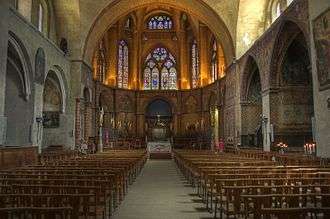Cahors
Understand
Almost entirely surrounded by water, Cahors, France is a lovely medieval town in the heart of the French wine country. It is the business and cultural centre of the region.
Cahors was a major town during the Middle Ages and saw a good deal of conflict during the Hundred Years' War.
Pope John XXII was born in Cahors in 1249.
Most of its key structures were built in the 20th century.
Cahors was the starting point of stage 18 in the 2007 Tour de France.
Get in
By plane
The nearest major airports are in Toulouse and Rodez.
By train
If flying into Paris, tourists are able to take the train to Cahors (approximately 5 hours).
By car
Get around
See
- Boulevard Gambetta. As the main thoroughfare, the boulevard is a popular area. A market is held there twice a week. It is named after the popular French leader Léon Gambetta (1838–1882) who was born in Cahors.
- Cathedrale Saint-Étienne de Cahors (Cahors Cathedral). Consecrated in 1119, the Roman Catholic cathedral is a Périgord style church. It is a great example of Gothic architecture.
- Museum Henri-Martin. A collection of local artifacts.
- Pont Valentré. The reason most people visit Cahors is to see the Valentré Bridge. Built during the 14th century, it took seventy years to complete. There is a legend that the builder of the bridge made a deal with the devil to help complete it. During its restoration in the 1800s, a sculpture of the devil was added to the top of one of the three towers. The bridge is in the northwest corner of the city and known as the finest medieval fortified bridge in France. It is one of the most photographed monuments in the country and is listed as a UNESCO World Heritage Site.
Do


Buy
Eat
The food in Cahors is typical of Southwestern France. It is hearty and uses local produce.
Drink
Cahors is a major producer of wine. It is mostly known for its red wine. 70% of the vineyards in France are along a narrow strip of land on each side of the Lot River between Cahors and Puy L'Eveque. Local soils are conducive to grape growing. There are 4,200 hectares (10,000 acres) of Cahors vineyards. The area produces 30 million bottles a year.
